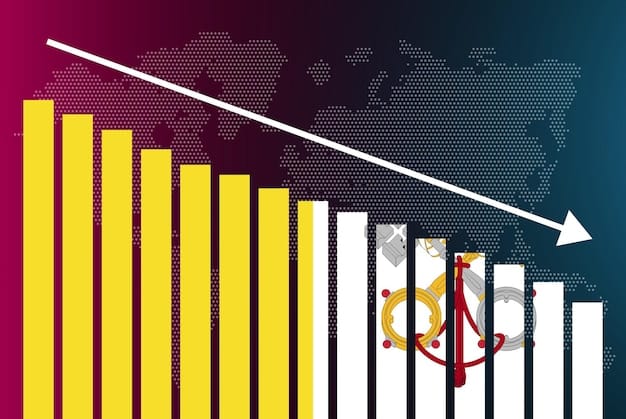Availability Heuristic & US Risk Perception: An In-Depth Look

The availability heuristic significantly shapes how individuals in the U.S. perceive risks, often leading to skewed assessments based on readily recalled vivid or recent information rather than objective data, profoundly influencing public opinion and policy.
Understanding how does the availability heuristic affect risk perception in the US? is crucial in today’s information-saturated landscape. This cognitive shortcut, where judgments are based on the ease with which information comes to mind, profoundly influences how Americans assess dangers, from public health threats to financial pitfalls, often shaping personal decisions and national discourse.
The Cognitive Shortcut: Understanding the Availability Heuristic
The availability heuristic is a mental shortcut that allows people to make judgments about the probability or frequency of an event based on how easily examples or instances come to mind. In the context of risk perception, this means that events that are easily recalled—perhaps because they are recent, vivid, or widely publicized—are often perceived as more likely or more common than they actually are. This cognitive bias plays a significant role in shaping individual and collective understandings of danger.
For instance, after a highly publicized airplane crash, people might overestimate the risks of flying, even though statistical data shows air travel remains remarkably safe. The vividness of the media coverage makes the event more “available” in memory, distorting the actual probability. This phenomenon is not limited to dramatic events but can influence perceptions of everyday risks as well.
Defining Cognitive Biases and Heuristics
Cognitive biases are systematic patterns of deviation from norm or rationality in judgment. They are often studied in psychology, cognitive science, and behavioral economics. Heuristics, on the other hand, are simple, efficient rules that individuals use to form judgments and make decisions. They are mental shortcuts that typically involve focusing on one aspect of a complex problem and ignoring others.
* 🧠 **Cognitive Biases:** Systematic errors in thinking that affect the decisions and judgments people make. They are often unconscious and can lead to flawed reasoning.
* 🚦 **Heuristics:** Mental shortcuts or rules of thumb that simplify complex decision-making processes. While often efficient, they can sometimes lead to biases.
The availability heuristic is one of several such shortcuts, alongside the representativeness heuristic and anchoring bias, all of which contribute to how individuals process information and make decisions, particularly when confronted with uncertainty. In the US, where information flows rapidly and is often sensationalized, these biases can have magnified effects.
How Media Amplifies Availability
Media coverage, especially cable news and social media, has a profound impact on the availability heuristic. Sensational headlines, alarming statistics, and dramatic visuals make certain events highly memorable and thus more available for recall. This constant stream of information, often focusing on rare but severe occurrences, can inadvertently inflate public perception of their frequency.
Consider the coverage of rare diseases or acts of terrorism. While statistically uncommon, extensive media attention can make these threats seem pervasive, leading to exaggerated fears and protective behaviors that might not align with objective risk levels. The immediacy of social media further exacerbates this, allowing vivid, often unverified, information to spread rapidly and deeply embed within collective consciousness.
Historical Context: Precedents of Risk Perception in the US
Examining the historical landscape of risk perception in the US reveals a recurring pattern: public fears and concerns often surge in response to highly visible or impactful events, rather than a steady, data-driven assessment. This reflects the pervasive influence of the availability heuristic throughout American history, shaping policy, public discourse, and individual behaviors. From natural disasters to public health crises, the most vivid and accessible information tends to dominate the narrative.
Think about the various health scares that have gripped the nation over the decades. The swine flu pandemic of 1976 led to widespread vaccination efforts, partly driven by the vivid memory of past pandemics, even though the actual severity of the outbreak was less than initially feared. Similarly, the public’s response to environmental threats like acid rain or the ozone layer depletion was often galvanized by dramatic visual representations and stark warnings easily accessible through media.
Landmark Events and Public Reaction
A powerful illustration of the availability heuristic’s impact can be seen in the wake of specific landmark events. The September 11th attacks, for instance, dramatically altered the American perception of terrorism. Prior to 9/11, while terrorism was a concern, it was often viewed as a remote threat. The vivid, devastating images and constant media replays made the risk of terrorism exponentially more “available” in the public consciousness, leading to significant shifts in national security policies, travel regulations, and individual anxieties.
Similarly, the 1989 Exxon Valdez oil spill, despite not being the largest oil spill globally, became an iconic symbol of environmental disaster in the US because of its dramatic media coverage and the tangible images of oil-soaked wildlife. This event significantly increased public awareness and concern about environmental protection and oil industry practices, demonstrating how a single, highly available event can galvanize public opinion. Over time, these highly publicized incidents become reference points, influencing future risk assessments.
Evolution of Media Influence from Print to Digital
The evolution of media has continually reshaped how the availability heuristic operates. In the era of print and broadcast news, information dissemination was more controlled and often slower. While sensationalism existed, the ability for individuals to directly engage with and re-share content was limited. This meant that while major events certainly stood out, the sheer volume and speed of vivid information were constrained.
With the advent of the internet and social media, the influence of the availability heuristic has been amplified geometrically. News is instantaneous, graphic content spreads virally, and algorithms often prioritize emotionally charged or engaging material. This creates echo chambers where certain fears or narratives are constantly reinforced, making them highly available and seemingly more prevalent than they might be in reality. The transition from carefully curated news cycles to a fragmented, personalized news feed means that individuals are more susceptible to the vivid, immediate, and emotionally resonant information that confirms existing biases.
Key Mechanisms: How Availability Translates to Risk Perception
The translation of “availability” into “risk perception” occurs through several psychological mechanisms. The fundamental principle is that the easier something comes to mind, the more frequent or probable we judge it to be. This is particularly true for negative events, which often carry greater emotional weight and are therefore more memorable. The mechanisms often involve a blend of emotional response, media reinforcement, and personal experiences.
When individuals are asked to estimate the likelihood of an event, they don’t typically consult statistical databases. Instead, they quickly search their memory for examples. If many examples come to mind quickly, the event is deemed more likely. Conversely, if few or no examples are readily available, it is judged as less probable. This intuitive process, while efficient, is highly susceptible to biases introduced by factors like media salience or personal trauma.
Vividness and Emotional Impact
Events that are highly vivid or emotionally impactful are more easily recalled, regardless of their actual frequency. A dramatic news story about a shark attack, for example, is far more memorable than a statistic about the low probability of such an event. The emotional resonance of the story—fear, horror, shock—enhances its memorability and, consequently, its perceived likelihood.
This is why sensational headlines and graphic images are so effective in capturing attention: they leverage our natural inclination to remember emotionally charged information. The more vivid the memory, the stronger the impression of its prevalence. This mechanism can lead to an overestimation of the risks associated with rare but dramatic events, such as terrorist attacks or extreme weather phenomena, while less dramatic but more common risks, like heart disease or traffic accidents, might be underestimated because their impacts are often less visually striking.

Recency and Frequency of Exposure
Information that has been recently encountered or is frequently repeated tends to be more available in memory. This “recency effect” means that events that occurred just yesterday or last week will feel more probable than events from a year ago, even if their underlying frequency hasn’t changed. Relatedly, the more often we hear about a particular risk, the more likely we are to believe it is widespread or common.
Consider the fear of abductions among parents. While statistically rare, if news reports of child abductions are frequent, even if isolated incidents from different areas, the sheer repetition makes the perceived risk higher. This continuous exposure, fed by news cycles and social media trends, creates a false sense of high probability, guiding parental behaviors and public advocacy, sometimes disproportionately to the actual threat. The constant stream acts like a drumbeat, reinforcing the availability of the concept within one’s mind.
Personal Experience vs. Hearsay
While media and external information play a huge role, personal experience can also powerfully influence the availability heuristic. If an individual has personally experienced a negative event, or knows someone who has, that experience becomes exceptionally vivid and available. This firsthand knowledge carries significant weight, often overriding statistical data.
However, even hearsay, particularly from trusted sources or within one’s social circle, can contribute to availability. If friends or family frequently discuss a particular risk, those discussions make the risk more “available” in one’s thought process, even without direct personal experience. This blend of direct experience and social reinforcement further solidifies the impact of the availability heuristic on individual risk perceptions.
Societal Impacts: Influence on Public Opinion and Policy
The availability heuristic’s influence extends far beyond individual decision-making; it profoundly shapes public opinion and, consequently, public policy in the US. When a certain risk becomes highly available in the collective consciousness, there is often increased public pressure for government action, even if the actual statistical risk doesn’t warrant such a strong response. This can lead to resource allocation skewed towards highly visible, rather than scientifically significant, threats.
For example, public opinion on crime rates is often driven by highly publicized, violent crimes, even if overall crime rates are declining. This perception can lead to calls for “tough on crime” policies, increased policing, or stricter sentencing, which may not be the most effective solutions based on a broader understanding of crime statistics. The perceived severity and frequency, amplified by media, can dictate the political agenda.
Policy Responses to Perceived Threats
Understanding the availability heuristic is critical for policymakers, as public outcry fueled by vivid, available information can steer policy in directions that are not always data-driven or economically efficient. After a major natural disaster, for instance, there’s often a heightened demand for stronger infrastructure and disaster preparedness funding, even if a similar event hasn’t occurred in decades. While preparedness is necessary, the scale of investment might be disproportionate to the actual long-term probabilities, driven by the recent trauma and public memory.
Similarly, health policy can be heavily influenced. The response to the Ebola scare in 2014 demonstrated this. Despite only a handful of cases in the US, widespread media coverage and vivid imagery led to significant public anxiety and calls for drastic measures, including travel bans. Policymakers had to navigate a balance between necessary precautions and managing public fear largely amplified by the availability of alarming information.
Consumer Behavior and Economic Decisions
The economic ripple effects of the availability heuristic are substantial. Consumer behavior is often directly influenced by perceived risks, which are in turn shaped by readily available information. A highly publicized product recall, for example, can devastate a brand’s sales, even if the issue affects only a small batch of products or is quickly remedied. The vivid memory of the recall can taint the entire product line for consumers.
In financial markets, the availability heuristic can contribute to market bubbles or panics. News of rapid gains in a particular stock or sector can make those gains seem more common and attainable, drawing in more investors and inflating prices. Conversely, a sensational report of a market crash or a company’s downfall can trigger widespread selling, even if the underlying fundamentals are strong. The ease of recalling “get rich quick” stories or “market meltdown” narratives can unduly influence investment choices.
Public Health Campaigns and Communication
Public health officials frequently grapple with the availability heuristic when communicating risks. Convincing the public about slow-burning, less vivid threats like diabetes or heart disease, which are responsible for far more deaths, is often more challenging than mobilizing action against an acute, visually dramatic infectious disease. Campaigns often try to make these less “available” risks more vivid through personal stories and alarming statistics, to counter the bias.
For example, anti-smoking campaigns use graphic images of disease to make the long-term, abstract health risks more concrete and memorable. Similarly, campaigns against impaired driving often feature accident victims’ stories, aiming to make the potential consequences more readily available in the minds of individuals considering driving under the influence. The challenge lies in making risks salient without causing undue panic or misdirection of resources.
Mitigating the Bias: Strategies for Better Risk Assessment
While the availability heuristic is a deeply ingrained cognitive shortcut, it is possible to mitigate its effects and foster more rational risk assessment. The key lies in deliberately introducing more objective, comprehensive information into decision-making processes and encouraging reflective thinking rather than relying solely on immediate impressions. This requires active effort from individuals, educators, and institutions.
One primary strategy involves slowing down and consciously questioning initial risk assessments. Instead of immediately reacting to the most vivid information, individuals can be encouraged to seek out broader data sets, alternative perspectives, and statistical probabilities. This deliberate cognitive effort can help to counterbalance the natural tendency to rely on what easily comes to mind.
Data-Driven Communication and Education
A crucial strategy for mitigating the availability heuristic is the consistent and clear communication of objective data. When presenting risks, it’s essential to not only highlight potential threats but also to provide context through statistical prevalence, comparative risks, and long-term trends. This helps to ground perceptions in reality rather than allowing them to float on the waves of sensational media.
* 📊 **Statistical Context:** Always pair vivid examples with objective data. For instance, when reporting on rare but dramatic events, include statistics on how truly infrequent they are compared to more common risks.
* 📈 **Comparative Risk:** Frame risks in comparison to other, more familiar risks. For example, pointing out that one is more likely to be struck by lightning than win the lottery can put things into perspective.
* 🎓 **Education:** Teach critical thinking skills from a young age, empowering individuals to question information, seek verified sources, and understand the difference between anecdotal evidence and systematic data.
Public education campaigns, therefore, need to go beyond merely informing and actively work to “de-bias” the audience by providing tools for better risk assessment. They must acknowledge the power of vividness while simultaneously presenting the full factual picture.
Promoting Critical Thinking and Media Literacy
In an age of overwhelming information, fostering critical thinking and media literacy is paramount. Individuals need to be equipped to analyze news sources, differentiate between opinion and fact, and recognize the various biases inherent in both traditional and social media. This skill set empowers them to be more discerning consumers of information and less susceptible to the availability heuristic’s pull.
Teaching individuals how to evaluate the credibility of sources, recognize sensationalism, and understand the algorithms that personalize their news feeds can significantly reduce the impact of readily available, yet potentially misleading, information. Workshops on cognitive biases and their real-world implications can also be beneficial in making people more aware of their own mental shortcuts. This involves a shift from passive consumption to active, inquisitive engagement with information.
The Role of Experts and Trustworthy Institutions
Experts and trustworthy institutions play a vital role in providing reliable, data-driven information that can counterbalance the effects of the availability heuristic. When scientific bodies, public health organizations, or respected academic institutions communicate risks, their authority and rigorous methodologies can help to correct skewed public perceptions.
However, for this to be effective, these institutions must actively build and maintain public trust. This involves transparency in their methods, admitting uncertainties when they exist, and communicating complex information clearly and accessibly. In a climate where trust in institutions can be fragile, simply providing data is not enough; the information must come from a source perceived as credible and unbiased. Regular, consistent messaging from a variety of respected voices can help to reinforce accurate risk assessments over time.

The Future Landscape: Availability Heuristic in an Evolving America
As the US continues to evolve, so too will the ways in which the availability heuristic shapes risk perception. The rapid advancements in technology, the changing media landscape, and shifts in societal values will all play a role in how information becomes “available” and how it consequently influences our sense of security and danger. The future promises even greater challenges in distinguishing signal from noise.
The rise of artificial intelligence in content generation, the personalization of news feeds, and the increasing polarization of media outlets suggest a future where individuals may be even more selectively exposed to information that reinforces existing biases, making the availability heuristic potentially more potent. Countering this will require innovative approaches to education, media regulation, and community-building.
AI, Personalization, and Echo Chambers
The increasing sophistication of AI-driven content algorithms and personalized news feeds presents a complex future for the availability heuristic. Algorithms are designed to show users more of what they “like” or engage with, often creating echo chambers where individuals are primarily exposed to information that confirms their existing beliefs. This means that if a person has a heightened concern about a particular risk, AI will likely feed them more content related to that risk, making it even more available and seemingly pervasive.
This personalization can inadvertently amplify fears or downplay certain dangers, depending on the user’s initial leanings. Over time, this can lead to increasingly divergent risk perceptions across different demographic groups, making broad public consensus on issues like climate change, vaccine efficacy, or economic stability more difficult to achieve. The challenge will be to design AI systems that foster informed decision-making rather than merely reinforcing existing biases.
Global Events and Interconnectedness
The interconnected nature of the modern world means that global events now have a more immediate and vivid impact on risk perception in the US. A pandemic originating in one part of the world, for instance, is no longer a distant abstraction but a rapidly developing crisis documented in real-time across countless platforms. The availability of information about such events is instant, comprehensive, and often deeply emotional.
This heightened interconnectedness means that risks that were once considered geographically remote can become highly “available” in the American consciousness, leading to shifts in domestic policy and international relations. Whether it’s a financial crisis in Asia, a political upheaval in Europe, or a humanitarian crisis in Africa, the ease with which these events are broadcast and shared globally means they are more likely to influence American risk perceptions, even if the direct impact on the average American remains limited.
Building Resilience Against Misinformation
A critical challenge for the future will be building societal resilience against misinformation and disinformation, which directly exploit the availability heuristic. False narratives, when repeated frequently and presented vividly, can become highly “available” in public memory, making them difficult to dislodge even with factual corrections. This can lead to widespread misperceptions of risk, from health hoaxes to conspiracy theories about public safety.
Strategies for resilience will need to involve a multi-pronged approach: strengthening educational curricula to include media literacy and critical thinking, supporting independent journalism, developing tools for fact-checking and content verification, and fostering community dialogue that transcends partisan divides. Ultimately, empowering individuals to critically evaluate the information they encounter will be key to ensuring that risk perceptions are based on objective reality rather than manipulated availability.
| Key Aspect | Brief Description |
|---|---|
| 🧠 Cognitive Bias | Judgments influenced by easily recalled information, not objective frequency. |
| 📺 Media Amplification | Sensational news and social media boost memorability of rare events. |
| 🏛️ Policy Influence | Public perception, often biased, drives governmental and economic decisions. |
| 🛡️ Mitigating Strategies | Data-driven communication, critical thinking, and institutional trust help counter bias. |
Frequently Asked Questions
▼
The availability heuristic is a mental shortcut where people estimate the probability or frequency of an event based on how easily examples or instances come to mind. If memories related to an event are vivid or recent, it’s often perceived as more common or likely, even if objective data proves otherwise. This cognitive bias influences judgments across various aspects of life.
▼
Media coverage significantly amplifies the availability heuristic by making certain events more vivid and easily recallable. Sensational headlines, dramatic visuals, and frequent reporting of rare occurrences can inflate public perception of their actual frequency or likelihood. Social media further exacerbates this by rapidly spreading emotionally charged information, creating a distorted view of reality.
▼
Yes, the availability heuristic profoundly affects public policy. Public opinion, often shaped by readily available and vivid information, can create pressure for government action. This may lead to policies being implemented based on perceived, rather than statistical, risk, sometimes resulting in disproportionate resource allocation towards highly visible threats over more widespread, but less dramatic, issues.
▼
Individuals can mitigate this bias by actively seeking out objective data, practicing critical thinking, and exercising media literacy. Consciously questioning initial impressions and comparing personal anecdotes against statistical probabilities helps. Engaging with diverse information sources and understanding how cognitive biases work can also reduce susceptibility to relying on easily recalled, but potentially misleading, information.
▼
The future suggests an increased influence of the availability heuristic due to advancements in AI, personalized content algorithms, and global interconnectedness. These factors can create echo chambers and amplify misinformation, making certain risks seem more pervasive. Building resilience against these forces through education, critical thinking, and fostering trust in reliable institutions will be crucial.
Conclusion
The availability heuristic remains a powerful and pervasive cognitive bias, profoundly shaping how individuals and the collective in the US perceive risk. From influencing policy decisions to altering consumer behavior, the ease with which information comes to mind often overrides objective data, leading to skewed assessments. As our world becomes more interconnected and digitally driven, understanding and mitigating this heuristic will be increasingly vital for fostering more rational decision-making and a more accurate understanding of the myriad challenges facing American society.





